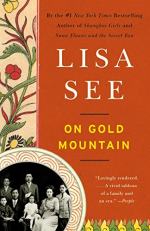|
This section contains 884 words (approx. 3 pages at 400 words per page) |

|
On Gold Mountain Summary & Study Guide Description
On Gold Mountain Summary & Study Guide includes comprehensive information and analysis to help you understand the book. This study guide contains the following sections:
This detailed literature summary also contains Topics for Discussion on On Gold Mountain by Lisa See.
The following version of this book was used to create the guide: See, Lisa. On Gold Mountain. St. Martin's Press, 1995.
Fong Dun Shung, the author’s great-great-grandfather, arrives in the United States in 1867 to work on the transcontinental railroad. He was spotted by a railroad scout near his home village of Dimtao, China, and hired for his herbal knowledge. In the Sierras, he helped injured and ailing Chinese laborers with his natural medicines. Back in Dimtao, one of his sons, 14-year-old Fong See is given passage to Gold Mountain, the name for the United States. Fong See finds his father in Sacramento, where he had opened an herbal shop once the railroad was completed. His father returns to China, and Fong See stays in Sacramento. Although he tried a number of manual labor jobs including farming and laundry work, Fong See found himself suited for selling wares, and he opened his own business.
At first, Fong See manufactured and sold ladies underwear for brothels, but after he meets Ticie, a young woman from Oregon, the shop begins to sell regular ladies’ underwear, baskets, and porcelain items. Ticie, an 18-year old adventurous and business-minded young woman, marries Fong See, nearly 20 years older than her. Because California law does not allow marriage between Caucasian and Chinese, they have a simple contract. Ticie’s family disowns her for marrying a Chinese man. Fong See and Ticie move to Los Angeles in 1897 hoping for more opportunity in business and, hopefully, for better treatment of Chinese immigrants.
While many questionable laws have been passed to limit Chinese immigrants’ prosperity—for example, they could not own land nor own a business other than a merchant’s—Fong See was determined to work around the California legislation as best he could. The F. Suie One Company continued the ladies’ underwear business, but eventually phases it out for the more profitable selling of curios, furniture and antiques. The company becomes profitable, and they open several more stores. The family—Fong See, Ticie and their two children Ming and Ray—travel to China in 1901. They meet Yong, Fong See’s arranged marriage to a 10-year old girl before he left for the United States decades ago. After Fong Dun Shung and his wife meet Ticie, they tell Fong See that Ticie is the number one wife and should be his only one.
After returning from China, Fong See and Ticie have three more children: Bennie, Eddy and their only daughter, Sissee. Ticie, although embracing much of Chinese culture in food and customs, does not bring up her children in the strict Chinese discipline, and this is a point of contention between Fong See and Ticie. The siblings are close to one another simply because, being half-Chinese and half-Caucasian, they are rarely accepted in either community.
After WWI ends and nineteen years from the previous trip, the Sees again take a family trip to China. Fong See’s father and Yong have died and his mother is ill. They teach Ming and Ray to distinguish fine porcelain and antiques. Fong See and Ticie’s relationship is strained when Fong See begins to purchase land and factories in China that Ticie deems unnecessary. Plus, Fong See wanted Eddy to stay behind in China to take care of his ill grandmother. Refusing to split the family, Ticie uses her own money to buy tickets for her and the children, and they leave China six months earlier than expected.
Fong See stays in China, builds a hotel in Fatsan, a large and grand house in Dimtao, and finds a 16-year-old peasant girl for Ming to marry. However, Ming and Ray, in the roaring 20s, have become playboys and Ming has already married. Fong See marries Ngon Hung himself. When she gives birth to a daughter, Ticie files for separation. The business is divided, and the See siblings work with Ticie in the F. Suie One Company.
The siblings marry and embark on their own familial lives, but most work in the family antique business. Ray and Bennie open a furniture making business that becomes highly profitable. The Depression hits and Eddy takes a gamble on opening up a restaurant called the Dragon’s Den which was highly popular with Hollywood celebrities, interracial couples and homosexuals. Meanwhile Fong See, who has married a fourth wife in China, hopes to retire there. However, Japan invades China in 1937, and Fong See, nearly 80, moves his second family back to Los Angeles for safety. He resumes control of his antique business, and his store is close to Ticie’s.
Ticie’s last wish in life is to see her daughter Sissee married, and she dies less than seven months after the wedding at the age of 66. Eddy See and his wife have one child, a son named Richard. Richard See, although having a crush on his half-aunt Sumoy, eventually marries Carolyn Laws. Their child is Lisa See, the author of the book. Fong See dies at nearly 100 years old in 1957. Ray retires from the furniture business, but most of the See siblings work at the antique store in Los Angeles, until, they too pass away one after the other: Eddy, Ray, Ming, Bennie, and, finally, Sissee, who, before her death, asked the author to write the story of their family.
Read more from the Study Guide
|
This section contains 884 words (approx. 3 pages at 400 words per page) |

|



